Timothy Ferriss's Blog, page 122
May 15, 2011
The Random Show, Episode 14/15 – Bourbon, Photography, iPhone Apps, and Start-ups
Random Episode 15 from Glenn McElhose on Vimeo.
In this long-overdue episode of Random, Kevin Rose and I discuss everything from start-ups and photography to naming products, iPhone apps, and survivalist training. Fueled by bourbon and pizza — cheat day, of course — we had a blast.
Hope you enjoy! The mentioned links, assorted goodies, and show notes are below.
Last but not least, The Random Show is now on iTunes! If you simply want audio-only, or if you'd like to watch the episodes on your iPhone or iPad, here you go:
VIDEO: http://itunes.apple.com/us/podcast/the-random-show-podcast/id417595309
AUDIO: http://itunes.apple.com/us/podcast/the-random-show-podcast-audio/id417635513
Milk, Inc.
http://milkinc.com/
Daniel Burka
http://www.deltatangobravo.com/
Path
http://www.path.com/
Business Insider – 15 Greatest Tech Pivots
Bessemer's "anti-portfolio" (mistakenly referred to as Accel's anti-portfolio)
http://www.bvp.com/Portfolio/AntiPortfolio.aspx
Control 4 Home Automation
http://www.control4.com/
Panasonic LUMIX G 20mm f/1.7 Aspherical Pancake Lens
Christopher Michel – Photography
http://www.christophermichel.com/
Matt Mullenweg
http://ma.tt/
Power: Why Some People Have It And Others Don't, by Jeffrey Pfeffer
Benjamin Franklin: An American Life, by Walter Isaacson
Sedo
http://sedo.com
Domain names – hash tag for kevin on Twitter: #krdomain
IPA (phonetic alphabet) flash cards
http://ipaflashcards.com/
Evernote
http://www.evernote.com/
PDF pen – app
http://www.smilesoftware.com/PDFpen/
America: The Story Of US
http://www.history.com/shows/america-the-story-of-us
###
All previous episodes of The Random Show can be found here.

May 9, 2011
Semi-Finals: Scholarship for Opening the Kimono

(Photo: Josh Liba)
NOTE: VOTING HAS ENDED — THANKS!
Once again, I have been BLOWN AWAY by you all.
Please find below the semi-finalists for the scholarship spot to the $10,000 Opening The Kimono event.
There are 26, listed in no particular order, as we could not narrow it down further. The case studies range from parents to students, from snowboarding to software, from Berlin to British Columbia. Here's the next step:
1) Each video is a combination of three video submissions. After watching each video, vote for your favorite of the three applicants. Voting ends this Thursday, May 12th, at 12 midnight PST.
2) Once tallied, this round of voting will decide the 8-10 finalists for the next round.
Much like the Cold Remedy video case studies, these videos remind me of how much I owe you all. This kind of feedback is the reason that I continue to write, despite how hard it is for me, and why I love this community so much.
Thank you.
I hope you love these as much as I did. If you need a little inspiration, these are exactly what the doctor ordered.
Enjoy!
NOTE: VOTING HAS ENDED — THANKS!
NOTE: VOTING HAS ENDED — THANKS!
###
Odds and Ends: Tim in Germany
I'm leaving from SFO for Germany as I type this, where I'll be for 1-2 weeks, mostly in Berlin.
Anyone want to throw a big party? Know any club owners so we can blow it out? Other recommendations for fun in Berlin? Can't wait to rediscover it, as I haven't been since 2004.
April 29, 2011
Five Minutes on Friday, Six Minutes on Saturday: Listen to Music, Save Japan; Email a Company, Save 200,000 Sharks
It doesn't take a lot of time, money, or sacrifice to do an incredible amount of good. Hence the name of this post (and potential series): Five Minutes on Friday. Even if it's not Friday, this post might interest you…
Can you — and can I — take just five minutes each Friday (or Saturday, Sunday, etc.) to fix big problems and feel awesome in the process? Sure. It need not suck or feel like work. In fact, it can be like getting a Christmas present. Or perhaps like slaying bad guys as The Punisher.
Pretty sweet on both sides. Here are two quick options for your five minutes this week…
Listen to Music, Save Japan
Make a $10 or greater donation to Music for Relief for earthquake and tsunami relief in Japan and receive a kick-ass exclusive compilation of music from incredible musicians. To get people to take action, the offer is only good for a few days. Listen to the music (listed below) and make a donation here: http://japan.downloadtodonate.org/
Current Tracklisting:
Hoobastank — Running Away (acoustic)
Shinedown – Shed Some Light (acoustic live)
Sara Bareilles — Song For A Soldier
Flyleaf — How He Loves (live)
Staind —Right Here (live)
The Red Jumpsuit Apparatus — 21 and Up
Angels & Airwaves — Hallucinations
Taking Back Sunday – Best Places To Be A Mom
Placebo – Bright Lights (live)
Black Cards – Dr. Jekkyl & Mr. Fame
B'z — Home
Surfer Blood – Take it Easy (Live)
Ben Folds – Sleazy
Slash featuring Myles Kennedy – Starlight (live)
Counting Crows – Colorblind (live)
R.E.M. – Man on the Moon (live from Tokyo)
Talib Kweli – GMB
Plain White T's — Rhythm Of Love (live)
Elliott Yamin — Self Control
Pendulum – Witchcraft
Patrick Stump – Saturday Night Again
Linkin Park — Ishho Ni
Pretty sweet, right? Click here to download the tracks.
Email/Call a Company, Save 200,000 Sharks
More than 100 million sharks are now slaughtered annually to fuel the shark fin soup trade. The soup is non-nutritive, expensive, and doesn't even taste particularly good (yes, I tried it in China in the 90′s). It is served mostly as a status symbol at Asian weddings, formal functions, and high-end restaurants.
How is this fine soup made?
Shark fins are cut-off the sharks in a process called "finning." The practice is wasteful, unsustainable and ecologically unsound. Here's how it works: sharks are caught on long-lines (miles of line floating in the oceans, affixed with hooks and bait), brought to the boat, and have their fins are hacked off. Next, since shark meat isn't worth as much as shark fins, the mutilated but normally live animals are thrown back in to the water to sink and die.
Sharks cannot reproduce fast enough to keep up with mass-production shark finning. In the Atlantic ocean alone, shark populations in many species have decreased more than 90% percent in the last 15 years alone. It's fucking disgusting.
I wanted to be a marine biologist for nearly 15 years, and if there is two things to remember about sharks, here they are:
- Most sharks don't attack humans and have no interest in us whatsoever. I've dived with hundreds of sharks without incident.
- If you destroy apex predators (predators at the top of the food chain), the rest of the food chain topples soon thereafter.
If the oceans go to hell, so do we. To stick it to the bad guys and help the good guys, here are two five-minute options:
1. Boycott and Publicly Shame Restaurants That Serve Shark Fin Soup
Below is a list of Canadian and US restaurants that still serve shark fin soup. Boycott them, write to them, and — corporations hate bad PR — publicly shame them for inhumanely slaughtering sharks, using blogs, tweets, Facebook, e-mail, or whatever you have:
United States List of restaurant perpetrators
Canada's list of restaurant perpetrators
2. Join Future Shark Adventures
The University of Miami offers year-round shark expeditions, including weekly tagging trips in the Florida Keys, Great White Shark expeditions in South Africa, and Diving and Tagging tiger shark adventures in the Bahamas. Click here for more information.
If you have other creative ideas on how to promote ocean conservation, please contact Dr. Neil Hammerschalg at nhammerschlag-at-rsmas.miami.edu. To learn more about shark protection, visit these sites:
http://www.wildaid.org
http://www.sharksavers.org
http://www.rjd.miami.edu
http://www.sharktrust.org
Yes, I really love sharks. Here, I tag my first shark off of Miami as part of Summit Series: a beautiful female tiger shark. Truly gorgeous.
Have a fantastic weekend, all. Take the five minutes if you can. It will make you feel incredible, and it will have an impact.







April 26, 2011
How to Bribe People to Start Companies (Plus: Kimono Event Scholarship)
Once upon a time, two entrepreneurs had an idea: what if we used traditional bookbinding to make iPad cases?
It was a fun idea.
Then it suddenly became very, very profitable. The two entrepreneurs, Patrick Buckley and Craig Dalton, named the idea DODOCase and soon had sold more than 10,000 iPad cases at $60 a pop.
Soon thereafter, they were featured in The New York Times and had a multi-million dollar business on their hands, to the tune to $4-5 million a year.
That could be you.
See, DODOcase was far from alone. They were part of a simple experiment, a business-building competition I launched jointly with an incredible start-up called Shopify.
The results were amazing:
Revenue PER HOUR for the duration of the contest: $696.38
Total number of orders placed: 66,503
Most important — Total businesses created: nearly 1,400
1,400 &^%$ing businesses, created by people just like you.
People who'd become comfortable in a routine. People who'd dreamt of starting their own company… someday. People who just needed a quick slap to get off the tranquilizers of their 9-to-5. But did I say "people just like you"? Scratch that — 1,400 businesses, many of them created by people far less capable than you.
The Shopify Build-a-Business competition is back, bigger and better than ever. There are more than $500,000 in prizes, including:
$100,000 Grand Prize
VIP trip for two to New York City, where Seth Godin will cook you dinner
One-hour power session with Gary Vaynerchuk
VIP trip to San Francisco, where you'll visit the Googleplex and have dinner (and wine, of course) with yours truly at one of my favorite restaurants in the world…
This time, it's also international!
The contest is open to residents of the U.S.A. (excluding residents of Arizona, Maryland, Vermont, and Puerto Rico), The U.K. (excluding N. Ireland), Australia, New Zealand and Canada. Regardless of location, EVERYONE can participate to take advantage of the educational portion. You don't need any experience starting or running an online store. Forget the "prizes." Those are just window dressing. The real prize is creating a profitable business that could be the next DODOcase, the next 4-Hour Workweek, or far beyond both.
GigaOM noted today:
"The competition isn't simply about the money. Shopify is teaming with marketing guru Seth Godin, wine video blogger and author Gary Vaynerchuk and angel investor Tim Ferriss, along with sponsors Google, MailChimp and PayPal to offer advice and counseling to start-ups. That along with AdWords credits help bring the total payout to $500,000."
To reiterate the dilemma and solution, as I wrote last time:
"This competition is intended as a benevolent and encouraging kick in the ass. This stuff isn't rocket science, but it does require stepping outside your comfort zone for a bit to realize: this isn't that hard. It's just unfamiliar. If you do it now, a lot of people will be in the same boat and you'll take the trip together."
Ready to join the ranks, shed a little blood with your brethren (mere papercuts, guys), and fundamentally change your life forever? If not now, when?
Go here. Get excited. Pull the trigger.
###
Related:
Looking for ideas? Browse some of the case studies in the "Engineering the Muse" posts, or successful examples on Shopify.
Learn lessons from past winners and runners-up
Odds and Ends: ONE Scholarship for $10,000 Event
As promised, I've thought a lot about financial aid requests for the $10,000 "Opening the Kimono" event in August.
I take your feedback seriously, but I also take the attendee selection seriously. I'll therefore be offering one "scholarship" (covering attendance fee) to a qualified doer. To separate the talkers from the doers, and to reward loyal readers, here's how a single winner will be chosen:
1) Upload a video to YouTube, no longer than 3 minutes, titled "4HB success story" or "4HWW success story," followed by your full name.
2) In the video, describe the results you've created from implementing something from 4HB and/or 4HWW.
3) Then, leave a comment on this blog post with "SUBMISSION" at the top of your comment and a link to your video.
4) My elves and I will choose 5-10 finalists.
5) Those top 5-10 will be voted on by the blog community to determine the winner.
Your video must be submitted no later than this Sunday, May 1, at midnight PST. Earlier submissions get priority in the case of any ties.
I will ask the winner for their last year's tax return and bank statements. If you can clearly afford it, the scholarship will go to the #2-ranked finalist. If #2 can clearly afford it, it goes to #3, and so on.
We look forward to seeing your videos, and to seeing one of you in Napa wine country in August!







April 20, 2011
The Non-Overnight Success: How Twitter Became Twitter
What did Twitter look like before it was Twitter? Let us begin the story with an image…
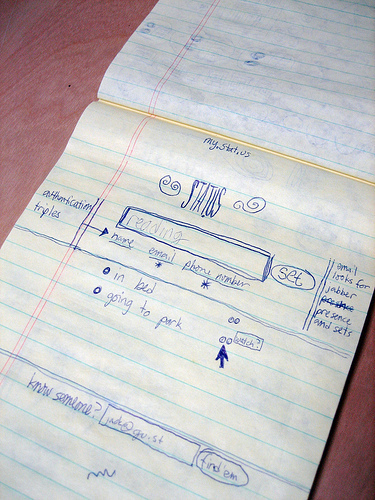
Jack Dorsey's first sketch for what would become Twitter (Photo: Jack Dorsey and d0tc0m)
This photo was first shown to me by Peter Sims, a former venture capitalist and now friend.
Pete and I share a number of common interests: wine, K-os, long dinners, and above all… little bets.
It's a favorite topic of conversation.
Perhaps a year ago, after a quick tour of the Stanford Institute of Design (d.school), Pete and I sat talking about start-ups in Tresidder dining hall. He was working on a new book about innovation, which he wanted to bridge different worlds, to explain the shared traits of the game changers.
The question he posed was simple: if you look at the biggest successes in the world, whether Apple CEO Steve Jobs, comedian Chris Rock, or award-winning architect Frank Gehry, what do they have in common?
Answer: the bigger they are, the more small bets they make.
Becoming the best of the best is less about betting the farm (a common misconception) and more about constant tinkering. Within Pixar or within Amazon, there is a method to the madness, but it's not haphazard risk-taking.
In the following guest post, Peter will look at the unlikely evolution of a little tool. It's a little tool now used to overthrow governments, and a tool that's become a company some value at more than $10 billion: Twitter.
How the hell did it happen?…
Enter Peter Sims
We're taught from a young age to avoid errors and failure at all costs, yet as any successful creator or entrepreneur will attest, breakthroughs don't happen without them.
So we have to be willing (and able) to think differently. Instead of trying to develop elaborate plans or perfect ideas, we need to make small, affordable bets in order to learn quickly, build momentum and networks, and expand our abilities and resources in order to discover unique ideas and opportunities.
Consider how Twitter came about. It didn't happen overnight. Jack Dorsey had been, in his words, "obsessed" by how people moved, interacted, and communicated since the early 1990s. So, he learned basic computer programming, created maps with dots on them, and used information from Manhattan dispatch systems to track the movement of bike messengers, taxis, police, firefighters, and couriers. It was a start.
Dorsey then transferred to New York University and got a job as a programmer with the largest dispatch company in the world. He learned a lot in the role and eventually focused on the short format messages that people sent to large dispatch boards. "This became the basis for all of my work going forward," he recalled.
After moving to the San Francisco in 2000, Dorsey continued to tinker with short messaging ideas. He started a company that dispatched emergency and taxi services from the web, but soon realized how little he knew about start-ups. Coming at the end of the dotcom era, the timing was bad, too. "The company scuttled and was more or less a failure," he acknowledged.
Yet he would learn from it.
Dorsey continued to use instant messaging and LiveJournal (the early blogging platform) to post updates on what he was doing – simple things like, "I'm on the phone" or "I'm listening to the Black Eyed Peas." Once again, these were small, achievable steps toward Jack's larger interests.
Then one night, Dorsey couldn't sleep and sketched out an idea on a white board. The idea was to exchange short "status update" emails with friends using his RIM 850, a predecessor to the BlackBerry. The device had four lines of text good for short format messaging, but unfortunately his friends didn't have RIM 850s.
So that experiment didn't go anywhere either, but Dorsey got little bit smarter, a little bit better, and a little bit closer to a big idea.
Around that time, Dorsey sketched out what would become the basis for Twitter several years later. On top it reads "STATUS," followed by a short fill-in the blank where he wrote "Reading." But lacking resources, Dorsey had to get a real job while continuing to tinker on the side.
Dorsey was eventually hired as an engineer at Odeo, a podcasting company where people weren't in love with podcasting. The company was, in fact, going nowhere, so founder Evan Williams asked employees for new ideas.
One night in 2006, Dorsey's colleague sent him the first text message he ever received. "I had no idea what this thing was," he remembered. But as Dorsey and his colleagues talked more about text messaging, he realized the short message format could be the missing link.
Williams gave him two weeks and another programmer to develop the idea. After the prototype was a resounding success internally at Odeo, Williams upped the ante for a six-month project then launched a full-scale version publically in July 2006. Twitter would consume more and more resources until Williams spun it off as a separate company in 2007.
Of course, luck was an important factor, but Dorsey's approach was brilliant. He focused like a laser on short messaging and made hundreds (if not thousands) of small, affordable bets in that area, most of which failed. But with each step he got slightly smarter, better, and closer until he ultimately achieved a remarkable feat.
It's an approach that the best entrepreneurs and creators have learned to do well, but anyone can do it. Jack began when he was a programmer.
It begins with a little bet. What will yours be?
# # #
More on Peter Sims: The above guest post is by bestselling author and former venture capital investor Peter Sims. His new book is Little Bets: How Breakthrough Ideas Emerge from Small Discoveries. For a free excerpt, click here.







April 18, 2011
Built to Sell — Making Your Company Sellable

Waterfall in Aix-en-Provence, France. (Photo: Mat3270)
"Didn't you write that you believed BrainQUICKEN couldn't be sold?"
The question — a common one — was from writer John Warrillow and for an article in Inc. Magazine.
The embarrassing answer was "yes." In 2005, I had assumed it was impossible to sell my then start-up and, as with most assumptions, I was dead wrong. I sold BrainQUICKEN in 2009 and learned volumes in the process.
For example: counter to expectations, I ended up caring more about lack of strings than maximizing price…
Several chess moves into price negotiation, after the suitor and I had arrived within 10% of each other, I offered to reduce the asking price 20% in exchange for the elimination of most "reps and warranties." This would give me a clean break, financially and emotionally, and it would dramatically speed up the sales process. I don't regret that apparent "concession" and would make the same decision in a heartbeat. If I'd been tied to the business, I doubt The 4-Hour Body would have been written.
Lessons learned, part deux: branding and customer databases are sometimes worth as much as defensible "hard" intellectual property. This realization eluded me for years, and in retrospect, it was ridiculous self-denial. Trademarks and distribution relationships can be sold at a handsome profit, both of which I'd undervalued, blinded by my own hands-in-the-air resignation related to lack of patents.
Silly rabbit.
John, on the other hand, provides the contrast. He has dodged these bullets multiple times, and done so by design.
John, you see, does more than write. He has started and successfully exited four companies, most recently a subscription-based research business sold to a publicly traded company in 2008.
From the standpoint of lifestyle design, John lives in Aix-en-Provence where he's struggling to master French, "despite listening to more Michel Thomas than any one man should have to endure." He's built a location-independent life full of adventure for his family, rather than signing on to miserable consulting gigs or "earn-outs" pegged to acquirers.
How does he do it?
Moreover, how do you ensure your start-up or muse is sellable from the outset? Is it possible to create something "built to sell"?
That's what this post hopes to answer, and it will discuss the recipe John has used for himself.
Enter John Warrillow.
How to Turn Your Muse into a Sellable Company
When I first heard Tim had sold his muse, I was intrigued. Here was the swashbuckling lifestyle designer who has told us all to create a muse to finance our new lifestyle, and yet he was selling his.
I had to know more, so I interviewed Tim for a column I write for Inc. He explained: "Even though BrainQUICKEN was only taking a couple of hours a week to run, it felt like my brain was constantly running antivirus software, and I wanted to free up those cycles to think about other things."
If creating a muse gets you into the Lifestyle Olympics, building a muse you can sell gets you a gold medal. In this post, I'm going to talk about how you can turn your muse into a sellable company so that you have the world by the tail: you can sleep well at night knowing you're sitting on a valuable asset, indulge in Ferriss-like "mini-retirements" while your business spits off cash and, when you're ready, sell your muse to a third party—because, as Tim will tell you, the only thing better than a low-maintenance muse generating cash to fund your lifestyle is a no-maintenance bank account doing the same.
Turning your muse into a sellable company
I'm going to define a "sellable business" as one that is not dependent on you to thrive. For anyone to want to buy it, your business has to be valuable even after you've left. I'm also going to assume you have a muse up and running. If not, refer back to Tim's advice for creating a muse in The 4-Hour Workweek.
The first step in turning your muse into a sellable business is to reengineer your offering to ensure it meets three criteria important to acquirers:
1. It's teachable
You need to be able to teach employees or suppliers (or be able to program technology) to do most of the work. That means the delivery of your product or service can't be dependent on you showing up. If you have developed a yoga DVD and teach yoga classes, you can probably teach others to fulfill DVD orders, but your yoga classes need you. To create a sellable muse, focus on the part of your muse that can run without you.
2. It's valuable
To create a sellable company, you need to have something others couldn't easily replicate, which means you need to find a quiet niche without a lot of competition. Recently Tim highlighted Guerrilla Drum Making as a muse that provides customers a video on how to make a drum kit out of everyday products available at Home Depot. While there are a ton of on- and offline music stores, Guerrilla Drum Making has carved out a unique spot in the musical instrument market by helping handy parents and aspiring musicians build a drum kit that is both professional-looking and unique. It's a nice little niche, one that will allow the owner to control how he gets paid, which is critical to increasing the overall value of a business—more on that in a minute.
3. It's repeatable
The hardest yet most important part of turning your muse into a sellable company is building a recurring revenue model. When potential acquirers look at your muse, they're going to want to understand how revenue is going to come in after you are gone. There are six basic models of recurring revenue. In order of least to most valuable in the eyes of an acquirer, they are as follows:
- Consumables: Tim highlighted Hewley shampoo in a recent post. This is a classic "consumable" product since most people need to buy a new bottle of shampoo every month or so. Once customers become loyal to a brand, the company begins to enjoy some recurring revenue.
- "Sunk-Money" Consumables: When you buy a Gillette Sensor razor, you're much more likely to buy a five-pack of Gillette Sensor blades every month than to buy another brand because you have "sunk money" into the razor and have become invested in a platform.
- Renewable Subscriptions: More valuable than simple consumables in the eyes of an acquirer are subscriptions. In this video of Tim highlighting successful muses, he mentions Everyday Genius, where customers pay first and then get the product over the life of the subscription. Acquirers prefer the predictable nature of subscription revenue over the consumable model of recurring revenue.
- "Sunk-Money" Renewable Subscriptions: A muse ascends to the next rung on the value ladder when customers make an investment to become subscribers. I recently bought an Apple TV box and a $9.99/month Netflix subscription. I'm more likely to renew my Netflix subscription because I have sunk money into the Apple decoder.
- Automatic-Renewal Subscriptions: As valuable as a subscription muse is, an auto-renewal subscription business that has the right to bill customers until they say stop is even better. Unlike a traditional magazine subscription, an auto-renewal subscription means subscribers don't have to make a conscious re-up decision each year, so the business is more likely to keep them around longer. For example, when you store documents with Iron Mountain, it just keeps billing you until you say stop.
- Contracts: The most valuable form of revenue is guaranteed into the future in the form of a contract. If you are lucky enough to get long-term contracts from your customers, include a "survivor clause" in them to ensure that the customer's obligations "survive" a change in ownership of your company.
Think of the recurring revenue model as a ladder you want to climb to get the highest possible price for your muse when you're ready to sell.
Re-engineer Cash-Flow
Once you have developed a recurring revenue model for your niche product or service that can be delivered without your involvement, the next step in getting the highest price for your muse is to rework your cash flow model so that your business stops sucking cash and instead starts blowing it out.
Here's why: When acquirers buy your business, they need to write two checks: one to you and a second to fund your muse's "working capital," the everyday cash your business needs to meet its immediate expenses. The smaller the check they need to write for working capital, the larger the check they're willing to write you for the purchase.
You want to change a negative cash flow cycle into a positive cash flow cycle. If you're paying for inventory before you sell it, your company has a negative cash flow cycle. Try to shift your model so you charge up front or on a subscription basis so that your business generates cash as it grows. This will make it more valuable when you sell it.
Track your statistics like Joe Mauer
In March 2010, Joe Mauer of the Minnesota Twins signed a contract that will pay him $184 million over the next eight years, making him one of the best-paid athletes of all time. One of the amazing things about Mauer is he combines two attributes rarely found in one player: a knack for both getting on base and hitting for power. The combination of these skills is expressed in a statistic called on-base plus slugging (OPS), which merges on-base percentage and slugging percentage—in Mauer's case, an almost unheard-of 1.031 during contract negotiations. Mauer's OPS—along with his three Gold Glove Awards and three batting titles—helped his agent Ron Shapiro sell Mauer's value.
When you go to sell your business, like Mauer, you will need a set of statistics that will help make the case for how valuable your company is in the hands of someone else. Tim has hammered us on this blog about the importance of metrics when growing your muse, so here are a couple of others to track as you shift your muse to the status of "sellable."
- Addressable Market Size: How many people in your geographic market buy what you sell? For example, let's say you have developed an English-language subscription for a yoga DVD series that is easy to ship within the United States. Your customers get four new instructional yoga DVDs per year, and you charge $99 annually. If three million Americans participate in yoga at least once per year, you could argue that your addressable market is three million people.
- Market Penetration Rate: What proportion of the target market have you sopped up, and how much is left for the potential acquirer to go after? Let's say you have sold 3,000 subscriptions since you started your yoga DVD muse. Therefore, your market penetration rate is 0.1%, and an acquirer would realize there is still plenty of field left to plow.
- Cost per Customer Acquired: How much does it cost you to acquire a new customer? Cost per customer acquired further breaks down into cost per lead and your conversion rate. For example, let's say it costs you $8 to get a lead from Google Adwords, and for every three leads you get, you close one subscription. In this example, your cost per lead is $8 and your conversion rate is 33%, so your cost per customer acquired is $24.
Think about what your business is worth in another's hands
These statistics become the raw material you need to make the case of what your business will be worth in the hands of an acquirer. For example, let's imagine a hypothetical magazine called Fit Girl has 800,000 subscribers. The publisher has heard about your yoga DVD subscription and is keen to diversify Fit Girl's revenue away from the traditional magazine business. She calls you to see if you're interested in selling your business.
Along with figuring out what she thinks your business is worth on the open market, she is also going to estimate what your business is worth to Fit Girl by making some assumption using the numbers you have been tracking:
- If 1% of the U.S. population likes yoga (your 3 million market size divided by the total U.S. population), then chances are at least 1% of Fit Girl subscribers—physically fit women—are into yoga. In fact, given the readership, Fit Girl might conservatively project its total immediate market for your DVD series to be more like 2% of 800,000, amounting to 16,000 subscribers.
- If you're picking up subscribers through Adwords for $24 each without your brand being a household name, Fit Girl will reasonably assume it can do at least as well with the power of its name. So the publisher might conservatively use your $24 cost per customer acquired to model out what her cost will be to get the 16,000 subscribers: $24 x 16,000 = $384,000.
In this hypothetical example, Fit Girl would conservatively pick up $1,584,000 worth of subscription revenue at a minimum. And if the stock market is valuing magazine companies at two times their revenue, buying your DVD series would give Fit Girl an easy $3,168,000 ($1,584,000 x 2) bump in market capitalization, which might lead to how the publisher would think about what your business is worth in her hands.
Acquirers will, of course, want to use low-ball industry comparables to value your company. To get the highest price for your business, you'll have to use your statistics to paint the picture of what the business is worth to them.
The last question you need to answer
With a recurring revenue model for your niche product, you'll be in a position to sell your muse. The only question left to answer is: when?
That's a toughie, and only you can answer.
Maybe you'll run your muse for years, indulging in amazing travel knowing you could sell when you're ready. That's a powerful position to be in. Maybe you'll decide that, even though your muse is profitable and low stress, it is worth more to someone else than it is to you—which is when you'll get the highest price for your business and minimize a soul-crushing earn-out.
Having all the cards in your hands starts by transforming your muse into a sellable company.
Welcome to the Lifestyle Olympics. Who's shooting for the podium?
###
John Warrillow is the author of Built To Sell: Creating A Business That Can Thrive Without You to be released by Portfolio / Penguin on April 28, 2011.
You can take his "Sellability Index Quiz" to find out how much your business is worth at www.BuiltToSell.com.

April 12, 2011
Opening the Kimono to 200 People and Baring It All

(Photo: E. Murray)
The most frequent question I get is:
"How did you hit #1 on The New York Times bestseller list?"
Historically, I've answered with "That's a long, long story." If pressed further, I would explain that I couldn't go into the details until I hit #1 a second time. Alas, in publishing and in life: once you're lucky, twice you're good.
Now, I can finally share the inside baseball of all I've learned (and witnessed) over the last five years.
For the first time, I'll be deconstructing the biggest hits in publishing, including the preparation and execution of launches for my two books, both of which hit #1 New York Times:
The 4-Hour Workweek… (published April 2007)
#1 New York Times, #1 Wall Street Journal, #1 BusinessWeek
Called "The most surprising self-help hit of the decade" by Men's Journal
More than 1,000,000 hardcovers sold in the US alone
Nearly four years unbroken on the New York Times Business Bestseller List
Sold in 35 languages, 60+ printings
An Amazon Top-10 Reader Favorite of 2007
AdAge "Best Product Launch for 2007"
Digital sales: 4.8% of total units
Advance paid: < $100,000 (signed before publication)
The media were kind in 2007, with quotes like "best self-promoter of all time" (Wired) and "branding wunderkind" (FastCompany).
But it wasn't me. Not at all. It was due to process. To wit, the 2010 release of The 4-Hour Body:
The 4-Hour Body… (published December 2010)
Instant #1 New York Times Bestseller, #1 six out of the first eight weeks
Nearly 500,000 books sold in the first four months
Selling at FIVE times the rate of The 4-Hour Workweek
The #1 most-highlighted book of all time on Amazon (screenshot here)
[Note: The 4-Hour Workweek is currently #5, just below the Bible]
First business author to jump non-fiction categories and create another instant #1 hit
Digital sales: 30% of total units, 90%+ of which is Kindle
Advance paid (largely based on the proposal's marketing plan): $2,000,000+
For the first time, I'm going to explain how my team did it all, ranging from flexible first principles and guidelines, to trench warfare and exact wording in pitches and partnership proposals.
It will be covered in a single seminar, planned as one-time-only –
OPENING THE KIMONO
Repeat Engineering of #1 — The Future of Book and Content Marketing
Dates: August 19 – 21, 2011
Location: California wine country, confidential retreat location. Details sent upon sign-up.
Available spots: Limited to 200 people.
Policies: No media coverage, no Twitter, Facebook, or other coverage of the event, and no recording whatsoever.
Who is it for?
Authors – Increase both advances and bestseller probabilities
Publishers/Agencies – Know which authors to bet on, sign bigger authors or win auctions, and increase your homerun ratio
PR/Marketing Professionals – Attract and retain the best clients who believe digital execution is the future
Anyone who wants to compete with (and learn from) the newest generations of whiz kids, rather than be defeated by them.
This seminar is not about buying your way onto the lists or the latest social media fads, though we'll explain the how people do the former. This seminar is a roadmap for the rarest of recipes: a repeatable and ethical content-creation and launch process that will put your product at the top and keep it at the top.
In sum: We'll cover all of the most important lessons I've learned (and witnessed) over the last five years — and discover how to find elegance in the chaos.
The experience will include exact details of:
* Building marketing into content creation, and the value of working backwards
* First principles and overarching strategies in a digital world: the core of testing
* Timing of PR and phased outreach — exact calendars and e-mails
* How to build a high-traffic blog in minimal time, plus fatal mistakes
* Borrowing approaches from movies, and the art of the calculated tease
* How and when to use pre-sales (almost no one gets this right)
* Tools and tricks for project management without micro-management
* Secrets of the "Lean Launch" model
* Review copies and advanced copies — viral approaches
* Uses and misuses of Twitter and Facebook (I'm an investor in both)
* How to test high-leverage contrarian approaches without betting the farm
* How to combine offline with online, and when not to
* Dozens of real-world case studies
* Special guests seldom or never seen in the book world
* Much, much more…
It will also include fine wine, extensive Q&A opportunities to address your specific situations/challenges, high-level networking, and, of course, the beauty and wonder of wine country.
Once this event is sold-out, it is sold-out. There are no plans to repeat it.
Cost:
$7,000 if you sign up this week
$8,500 if you sign up next week
$10,000 if you sign up the week after that
Just like TED and similar high-end events, flights and hotel are not included, but numerious surprise goodies will be provided on-site.
To sign-up for one of the 200 spots, please fill out this form. If you are new to this blog and are wondering — who the hell is this guy? — here is a short bio.
I look forward to meeting you and sharing a glass of Malbec. This will be an event to remember.







April 7, 2011
The Making of FUBU — An Interview with Daymond John
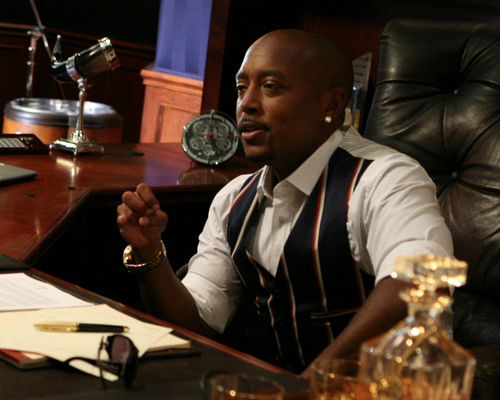
The following is an interview with Daymond John, CEO of the clothing brand FUBU, whom I've come to know and respect. If there were one mantra I'd associate with him, it's "where there's a will, there's a way."
Can't afford billboards? No problem — just pay retail store owners in key areas to let you spraypaint "FUBU" on their overnight roll-down security walls. His drive and improvisation has led him from sewing cloth in his kitchen to #15 on Details magazine's list of "50 Most Influential Men."
It would seem he's just getting started, but I'll let him tell the story…
TIM: Many entrepreneurs launch their companies in addition to working a full-time job. How did you manage your time when launching FUBU to get the company going? When did you decide to quit the day job and make this a full-time operation?
DAYMOND: It was incredibly tough, but the passion for the project pushed me through. If your project doesn't do that for you, well, maybe you need to sit down and revaluate. Even though I had placed our product in the hottest music videos out there, I was still working full-time at Red Lobster. To the public, FUBU was a huge company. Little did they know that I was still serving them shrimp and biscuits!
After a couple years of seeing FUBU as a hobby, I decided to get serious and stick to a standard daily schedule. I would wake up at about 7 or 8 in the morning, and I would sew the hats by myself, tag them, answer a couple of orders that came in overnight. Then I'd take the hats, package them, and begin to ship them out. I took care of all of that until about Noon or 1 PM. Then I'd hit up Red Lobster around 4, work there until midnight, come back home, make more hats, and tally up any orders until about 1 or 2 in the morning. I'd start the routine all over again the next day. I did this for about two years straight.
After my three friends joined the company, the business really started to take shape. With the extra hands, I was able to focus on growing the business at a much faster rate. At the point where I had enough money to quit (I didn't really have enough to quit the job, because I had taken out this $100,000 loan), I decided that I had to give the business all of my attention and effort. So I quit Red Lobster around '95-'96, and went completely full-time with FUBU.
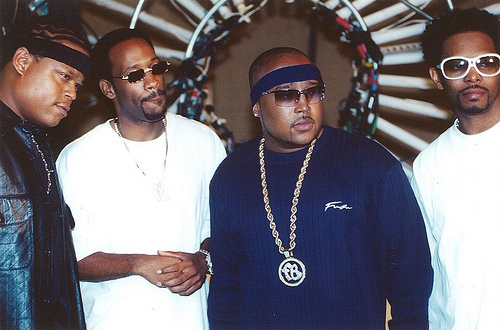
In entrepreneurship, you decide to give up your day job at the point where either (A) the hobby/new business is at least making some form of ends meet, or (B) you feel that you need to dedicate yourself for a certain amount of time to it and give yourself the last hoorah.
What were your initial struggles with launching FUBU and how did you overcome them?
Like most entrepreneurs, the initial struggle was to go past the point of imagination and make it a point of conception, where I was actually putting together a product and producing it. Everyone has an idea, but it's taking those first steps toward turning that idea into a reality that are always the toughest.
However, once you take those first steps you will be confronted with another obstacle, and I don't think there's just one tipping point for a company, but a string of them. For example, once I decided to put my idea on paper, I had to find a local screen printer. Then, I faced the challenge of increasing sales. Since I knew the stores wouldn't buy it, I put my product in them on consignment. After I got to the level of making more goods on a consistent basis, I had to figure out how to create a sustainable structure for manufacturing the product, so I mortgaged my house, moved sewing machines into my home, and hired seamstresses.
It's this string of obstacles that separate the people that truly want their company to succeed from everyone else, because so many questions hit you so fast. It's just a matter of not letting these challenges keep you down and finding solutions no matter what. It can be overwhelming at times but just be prepared for it. The more forward-thinking you are and the better plan of attack you have to grow the company, the easier these questions will be to answer.
What were some of your first big marketing wins to promote FUBU?
The first big break was when we went down to Virginia and met up with Ralph McDaniels, who had a video show like MTV and VH1, and he fell in love with our product. At the time, Ralph was throwing a big weekend event for Teddy Riley, a producer and musician that really shaped Hip-Hop and R&B. He came back to New York and decided to put us on a local video channel for an interview about FUBU. We all knew the FUBU brand was closely associated with music, but this hit created some immediate buzz and showed us the way to market our product unlike any fashion company out there yet.
We then concentrated in getting our product into music videos. We would sit on video sets all day trying to get the artists to wear it. First it started with Brand Nubian in one of their videos, then Ol' Dirty Bastard wore it in a Mariah Carey video, then Busta Rhymes wore it on one of his videos, and LL Cool J decided to wear FUBU on the "Hey Lover" video with Boyz II Men. Our product was front and center on the biggest and most influential personalities for our core consumers.
One of the most well-known hits we had with LL was during a Gap commercial. He was wearing a pair of Gap jeans and a Gap shirt, but he was somehow able to sport one of our hats during the commercial. Then during his thirty-second freestyle rap, he looks directly into the camera and says, "For Us, By Us, on the low." No one at Gap nor any of their ad execs thought anything of it. It wasn't until a month later that someone at the Gap found out, pulled the commercial, and fired a whole bunch of people after they had spent about $30 million running this campaign.
Historically, the Gap commercial is one of the biggest coups known to date in the advertising world. But in Gap's defense, they were smart enough to realize a year later that, because FUBU had limited distribution, African-Americans, Latinos, and the hip kids of all colors thought that FUBU was actually available at the Gap. So they saw their numbers spike during the LL Cool J campaign. Gap repackaged the same commercial and committed two times the amount of money in advertising that commercial in the following year. If you look back at Gap's numbers, that was around the time where they had some of their highest returns.
How did you take FUBU from a t-shirt and jeans company to a global brand?
This wasn't easy, and the best way to say this is that I ended up finding a great strategic partner in Samsung America, who understood global distribution. It's the basic lesson of starting a company: If you don't know how to do something, find someone who does. I could not have done this alone, whether it was by having the knowledge or financing it myself. Samsung directed me, guided me, and assisted me in my global expansion. Also, with a huge international company like Samsung on our side, we instantly had an incredible amount of clout with all the retailers.
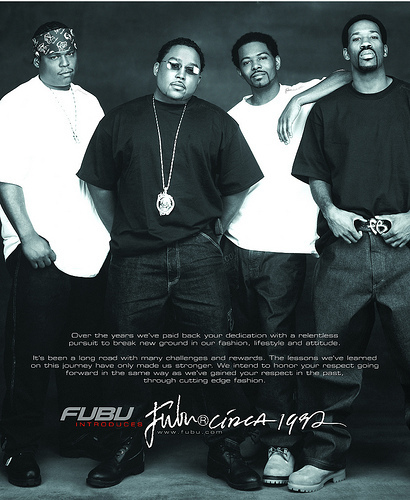
How important is social media for your various fashion brands? How do you best utilize it?
Extremely important. Even if you aren't putting out a message, the first thing that you can do with social media is find out and understand why people like or dislike your brand. This is like having a focus group—a focus group that's not sitting in your office, getting paid by you while you're looking in their face for them to give you an answer. You actually get to see the reality of what people think about you. And at that point, you have enough knowledge to make the proper adjustments. It's very hard to cure something if you don't know the ailment. Social media is a great acid test.
When I first started my brand before all this technology was available, it was just putting it out in people's faces and talking to them. But the good thing is, before you go and mortgage a house like I did, or sell the farm, you can push your brand out in the market and see how many orders you get on your website, how many people follow you on Twitter or friend you on Facebook, and request your product. This info will let you know if you have a winner or if you should go back to the drawing board and reconsider.
How have the fashion and soft goods business worlds changed since you started FUBU?
When I started FUBU, practically no one was directly addressing the young hip music/African-American, Latino market. Now there are many people addressing them. It's similar to how TV, at first, only had a couple of channels. Now there's a station for every topic, catering to every niche.
The fashion world has changed in that there's nothing new to target for a certain segment. Or at least, there isn't one on my radar. Maybe just how people didn't see FUBU's segment as an opportunity, it just isn't as apparent right now.
The most recent challenge is the increased price of cotton, which has dramatically increased the price to make goods. So you're going to start seeing one of two things. You're either going to see very clean, inexpensive goods where the products are basically white t-shirts, jeans, or things along those lines. Or you'll see it go in the complete opposite direction, where the luxury brands go overboard and bring in bigger numbers because they have the free retail stores. When you have retail stores, you can set up the goods the way you'd like them to be seen. The benefit of having a retail store is that there's no competition with other brands to slash prices, and you become 'one of very few,' instead of getting lost in the mix of other clothing lines that compete for space in the Macy's, the Burlington's, and all other department stores. So, it's a very challenging time for clothing companies right now.
Did you know much about manufacturing when launching FUBU? If not, how did you learn about it so quickly and effectively?
I did not know much about manufacturing—I did know how to sew, but that's different than manufacturing. Sewing is an ability; manufacturing is a knowledge. Manufacturing is about how much per square yard you are using and how to do technical packages. For example, you need the knowledge of how to interpret your designs for overseas, how to be cost effective, how much embroidery machines may cost per hour to run, how much it costs to ship the product back to the States, etc.
Luckily, one of my partners went to FIT [Fashion Institute of Technology] and he knew that side of the business. Also, working with Samsung, they were able to pass on that knowledge to me. It worked out well having that part of the company focus on that aspect, because it allowed me to focus on our marketing initiatives and how to keep the brand fresh.
If you don't have the partnerships available or you can't find a team member with that knowledge, try to intern or shadow for someone who does. It gives you a lot of hands-on experience and it's less expensive than paying for that education. Although you don't get compensated for it, at least you don't have to pay for it. If I had that internship experience before starting FUBU, it would have accelerated even quicker than it did. It probably would have cut the time I spent learning it on the fly in half. Education and knowledge is key. And I always say, the only thing more expensive than education is ignorance.
On your show Shark Tank, you must look at hundreds of companies. What's the first thing you look for when deciding whether or not to invest in a company? Do the other Sharks and investors you work with share the same approach?
After the first season, I realized that the first thing all investors look at is the person. When we're being pitched live, we always look at the person who is pitching and cast our judgment based on whether or not we would want to do business with them. After that, our ears are tuned to the things that will confirm whether our assessment is accurate—that they are a good or a bad person to be in business with.
This actually inspired me to write my book The Brand Within where I mention how we build upon our brand from the moment we were born; we also, inevitably, tend to make immediate judgment about others. And it's because of this, that we should always be conscious of our self-image, our brand, in order to maintain a desired reputation. It's something most entrepreneurs seem to forget when pitching me.
After measuring the person, you have to look at it from a totally business standpoint. I look at the product and ask a couple questions to myself. I focus on:
- What void in the marketplace does this product fill?
- Who are the core consumers? Has this company correctly marketed to them?
- What are the sales?
- What are the distribution channels?
- How much does this entrepreneur know about his own industry? (Note: HUGE pet peeve if he doesn't)
- Is the business on an upswing? Or has it peaked?
- Is there room for profit and growth?
- What is that plan for growth? Is it laid out or simply another idea in the entrepreneur's head?
- Is the evaluation of the company fair?
- How can I best help this company?
The answers to these questions are key and the entrepreneur should always be ready for these. If you don't have rapid-fire answers to these questions, there's a problem.
My favorite thing to look for is whether or not the product is proprietary or patented, and whether he/she can prove it. Not only do you have a documented competitive advantage, but it also means that in the event he or she is a bad business partner, you can potentially buy him or her out totally. However, at this point in the game, the evaluation of the company could be a little obstructed because of the potential inherited value that the patent holds.
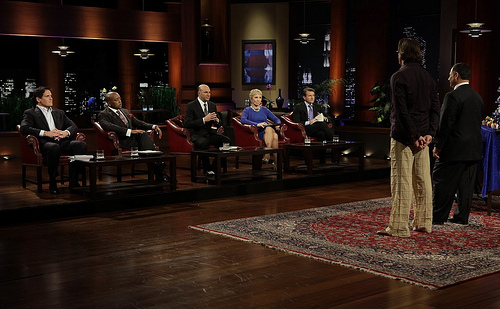
Do you think Shark Tank can educate entrepreneurs looking to take his or her company to the next stage of personal or financial growth?
I believe the educational aspect of the show is one of the best things for all entrepreneurs. I know undergraduate and MBA professors use the show as a tutorial for their entrepreneurship classes. It gives them something beyond text to show their students.
Members of the VC community love the show because it gives entrepreneurs a checklist of things they need to have in order to be taken seriously, such as sales numbers, how many stores they're currently in, patent info, can they pitch the product efficiently, etc.
When I started my business, I had no understanding of what investors were looking for and why they would want it. A lot of entrepreneurs just do not understand how to evaluate their product and make it attractive for others.
If people study the pitches to see what caught our attention and what completely lost us, you'll definitely be a lot more prepared. On my own site, I'm going to do commentaries with top professors, marketing strategists, and business executives to show viewers the real business lessons you can easily learn from the show.
In your opinion, should the entrepreneur focus primarily on promoting his company or promoting himself or herself?
Generally, I'd say that every penny and ounce of hardwork should be focused on the latter. I believe that in any business (or in anything in life), if you do not have a strong foundation, the rest will crumble. If you aren't 100% completely focused on your company, you can easily lose motivation or focus.
With all that said, I recognized when launching FUBU that "For us, by us" was such a powerful statement, and I knew that the world needed to see we actually meant it. That's why my three business partners and I were at the front of a lot of our advertising and media. It communicated to our community that we were authentic and so was our brand. You always need to keep in mind that people are constantly looking at you and your legitimacy to see if the company itself is legitimate.
What books, people, or media inspire your inner entrepreneur or teach you new lessons about business?
I love Think and Grow Rich. I think that it inspired more people because of its methods for setting goals to become a person of wealth. I also love Robert Kiyosaki's Rich Dad, Poor Dad because of its focus on financial intelligence.
Those who inspire me are the people all around me. I'm inspired by the people on Shark Tank—not just by my fellow sharks, but the people that pitch on the show, too. When I see the challenges they've had to overcome in life, and the crazy and ingenious things that they've developed, I'm humbled and amazed.
On the flip side, people who have failed and people who are currently failing also inspire me. I will always understand that I, too, could be one of those people if I don't take heat and learn lessons everyday.
What's next for you?
There's a lot coming up that I'm extremely excited about. Obviously, I'm still very involved in the fashion world. I'm working on some Shark Tank products that I've acquired during this new season. There are two companies in particular that I think are going to be huge. And I mean HUGE, so you'll have to check out the show this season to see what I'm talking about.
I've been doing a lot of keynote speaking at conferences, schools, and company functions. I used to do it sporadically, but now it's a major focus of mine. Whether I'm speaking about motivation, entrepreneurship, business negotiations, or marketing, it's extremely rewarding to speak to thousands of people at a time and share simple lessons I've learned that will make their own careers a bit easier or help them see life in a different way.
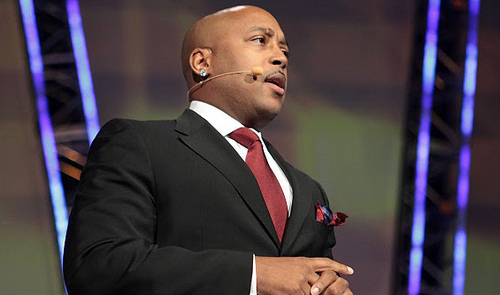
Another big project is a company I'm starting that shows a new marketing approach for what I see as the new age of media.
I believe there is a shift happening as to who actually controls the media (and will continue to hold it) that is very different from what everyone else is saying. I see the top-level celebrities out there as the new media vehicle. Consumers watch their every move in reality shows, social media, music videos, magazines, etc. They're the masters of both old and new media, and if brands want to stick out from their competitors, they need to align themselves with these celebrities. So I'm acting as a facilitator between brands and celebrities, and showing companies how their brand cannot only just be part of pop culture, but rather engrained throughout pop culture. The way I did that with FUBU was not just a random occurrence, and I know how to emulate that for any type of company.
For this project, I'm in the process of teaming up with the best possible strategic partners. As I said before, this is always key. On the celebrity side, I can't say exactly who I'm working with yet, but they're all A-list, household names. They're all looking forward to working with brands in ways that celebrities haven't been utilized before. One person I can say is on our roster is the music superstar Pitbull. Not only is he a huge international star, but the guy is incredibly sharp and savvy. He crosses so many genres and resonates with so many people, it's amazing.
On the business side, I'm already working with Jeff Hayzlett on a project for the Miss Universe Organization, which is very exciting because of the brand's huge global presence and I love working with incredibly intelligent people like Jeff. I'd love to team up with an advertising agency to give them access to our celebrity roster and our marketing insights.
I just need to find the right one that sees the true value in this direction.
###
AFTERWORD:
To download a free e-book copy of Daymond's book, Display of Power, follow the directions below:
1. Click this link: http://bit.ly/avAW4B
2. Fill out your name then use the following info to download:
- Referrer: Daymond John
- Password: theshark
March 24, 2011
Behind the Scenes: How to Make a Movie Trailer for Your Product (or Book)
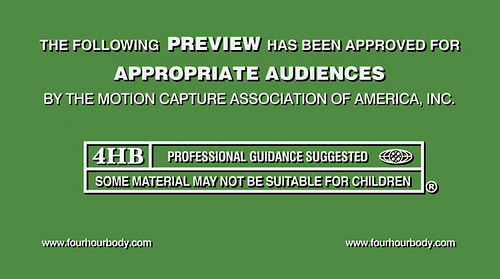
I first met filmmaker Adam Patch, courtesy of David Brundage on Facebook, over Thai food in San Francisco.
It was a warm evening in the Mission district, a good omen and unusual blessing. The goal of our meeting was simple: to see if we clicked and, passing that hurdle, to plot the making of "the best book trailer ever made."
Whether we pulled it off or not, that ambitious mission statement was necessary to survive the many all-nighters and hiccups that would follow.
August of 2010 was the starting point.
On November 30th, the end product was a 59-second trailer, which debuted on Huffington Post Books. It immediately took The 4-Hour Body from near #150 to #30 on Amazon, where it later climbed to #1.
The launch was initiated by a simple poll post, which was followed by an analytical second post. Due to its high production value, the video then made the jump from online to offline, eventually making it to national TV for The Dr. Oz Show (see the clip at :40).
This post will explain exactly how the trailer was created, including early concepts, tools, the team, and more…
Hitting the Pink Elephant First
Let's hit the most common question first. How much did it all cost?
I paid close to $12,000 total, but I also brought a lot of resources and co-promotional opportunity to the table. The same trailer done with a good freelancer could cost $40-50,000. If you choose a production company, which involves more moving pieces, it could add up to $100,000+.
But don't be scared away by the above numbers. Can you sometimes make budgetary miracles happen? Most certainly.
Emulating a Hollywood film is much more expensive than a slick demo trailer such as those produced by Epipheo, and the latter is better suited to many start-ups and services:
Second, it's easier to contain costs if you have a clear vision of your goal, as well as a clear picture of your would-be partner's longer-term goals. In my first fateful meeting with Adam, I slid a piece of paper across the table within ten minutes of us sitting down — the draft storyboard:

Click here for larger version.
Following up on our meeting, I sent him this e-mail:
Hi Adam,
OK, so here are some goodies to get your juices flowing.
Here is the basic book idea — I've made myself a guinea pig so you don't have to:
http://www.fourhourworkweek.com/blog/2009/06/22/the-next-book-from-rapid-fat-loss-to-strongmen-a-guide-to-becoming-superhuman/
The video clip in this mock-up vid (attached) is from an incredible gymnast in the UK, Damien Walters. I have an email in to him to see if we'd be able to use any of his stuff. Pretty amazing, but it'll give you an idea.
Current book cover is attached. I imagine it, some variation, or book/combo would appear at the end after the dude jumps over the car (perhaps even mid-air), or whichever visual we use.
Other potential vids for ideas:
Breathholding:
http://www.youtube.com/watch?v=Jn6cley8WDE (jump to :25 or so, seems very low-cost but potentially HD)
http://www.youtube.com/watch?v=uQITWbAaDx0 (just for fun)
Deadlift: http://www.youtube.com/user/Konstantinovs
Running: 2:35 or so forward here: http://www.youtube.com/watch?v=KRZvlQTTCMg
These are all starting points, but feel free to go nuts with your imagination. I want your ideas and input.
Look forward to your treatment!
Tim
How did it all hold up? Here's the final product in HD (give it some time to load):
Getting from that scrap of paper to spots on national TV was not easy.
The music portion alone almost killed the project. But the success of this trailer IS replicable.
The following interview and footnotes will explain the process and the lessons learned.
Adam Patch, interviewed by Charlie Hoehn (with comments by Tim)
Tell us a bit about your background.
My name is Adam Patch, and I directed and edited the trailer for The 4-Hour Body. I went to film school in San Francisco to learn directing, and got my start doing music videos, commercials, and motion graphics editing. I've been a freelancer for the last five years or so.
How were you chosen to direct the 4HB trailer?
I received a call from Tim one day, out of the blue.
He introduced himself, told me about the new book, and said he wanted to do a trailer for it. It sounded cool, and I hadn't really seen many book trailers, so I was intrigued by the idea.
When we first met up, Tim laid out his entire vision, which was pretty clear from the beginning. He already had the track from Sevendust ("Splinter") picked out, and knew he wanted to base all of the trailer's visuals around that song.
After our first meeting, I wrote up a treatment (which is just a specific outline of how I wanted to shoot the trailer and the energy I wanted to bring to it), presented it to Tim, and he was on board right away. Shortly after that, we went and filmed it on a two-day shoot.
[TIM: Here is the original treatment Adam presented to me]
What happened after The 4-Hour Body trailer came out?
It blew up. The trailer got a ton of great comments on YouTube [896 at the time of this writing], the hits on my website took off, and I got several calls from other publishers interested in doing book trailers. I've also been getting emails from film students who are interested in learning how I did certain effects. It's been really cool to see such a positive response to the video.
The trailer opens with a shot of Tim working at a table. Can you talk about that day of shooting?
We basically did a full day's worth of shooting at the atrium inside Tim's house. We knew that we were going to split it up, so we took our time finessing everything and really made sure all the shots looked nice. And visually-speaking, the atrium was super cool to photograph.
How Adam gave the atrium a cinematic feel in After Effects.
We brought all this stuff to make it look like a mad scientist lab, like he had been doing experiments on himself and taking notes. We shot that 30-second part of the video for probably six hours in one day. Then the following day, we drove all around the Bay, meeting up with each of the people in the video and shooting their little vignettes.
What goes into a six-hour shoot like that? Why does it take so long?
Almost all of that time was spent setting up lights. We lit up his whole atrium so it looked cool on camera, laid out a dolly track, and set up two cameras for shooting. We had a rough idea of what we wanted to shoot, but we were also exploring while we were there and coming up with ideas on the fly. For instance, there was one shot from overhead where the camera kind of drops down on Tim, and we didn't really plan for that shot.
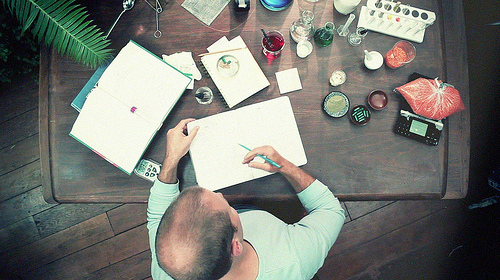
Typically, a shot like that would be done with a jib. But we didn't have a jib, so what we did is we had the camera up on two C-stands and had two of our grips lower them down slowly. That looked pretty amateurish while we were doing it, but we also couldn't see what we were shooting. We just put the camera up there and hoped it would work. So it was cool because it actually turned out pretty great.
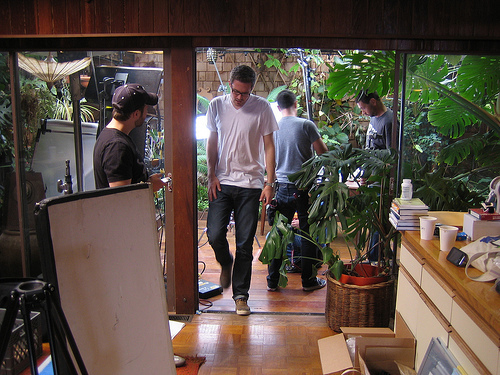


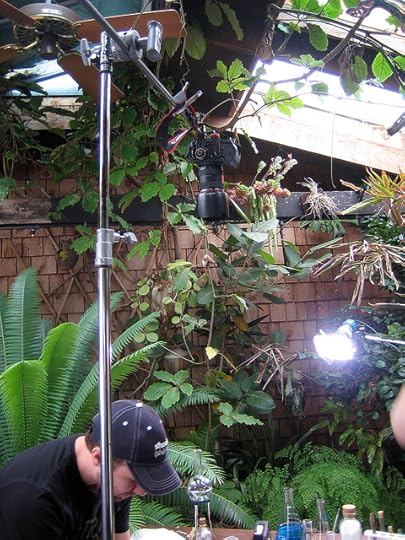
There's also a shot of a dilating eye. How did you guys shoot that?
We just had Tim sit in front of a camera with his eye closed for 20 seconds or so. We had a light nearby so that his eyes would quickly dilate when he opened them. Then I actually enlarged his pupil in post-production to make it even more noticeable.

What were the "holding your breath in the pool" shots like?
Those little pool shots were with Nathan Zaru. I remember it was kind of cold outside, and the water was freezing. And we had to keep doing take-after-take to make sure we got it right.
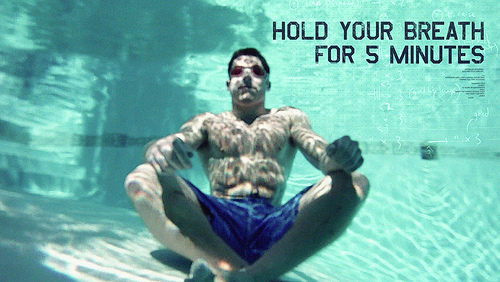
The camera we were using was the GoPro HD Cam, which is this really small HD camera where you can't see what you're shooting at all. It just has a fisheye lens. You shoot with it, and then you have to download the footage to see what it looks like. So we would do several takes with the camera from different positions, hoping one of them would work. In the meantime, poor Nathan is just sitting there freezing his ass off. By the end, his lips had literally turned solid blue, and we finally said, "Okay, that's probably enough. I'm sure we got it." It worked out.
How about the deadlifting shot in the gym?
We went down to Mark Wild's Wild Iron Gym in San Jose, which is a really tiny, grimy old-school gym. It's basically a big storage unit with a roll-up door, and there's a whole bunch of huge dudes working out inside. It was pretty awesome.
What was amazing about that shot was that powerlifter Mark Bell [our photo subject] was just in the middle of a workout. It wasn't like we were telling him to do the lift. I mean, he helped move stuff around to make it look good, but it wasn't as staged as I thought it would be. He was lifting about 600 pounds, repeatedly. He kept saying, "You guys want me to do it again?" It was nuts.


[TIM: Just for fun, compare the above "after" post-production shot with the below "before" still. The footage is exactly the same. Notice any differences?]

We also shot Tracy Reifkind with the kettlebell at the same location. We were trying to find a good spot to film her workout, and it was basically a parking lot and storage units. So we ended up lugging all of our gear onto the roof of the building and shooting.
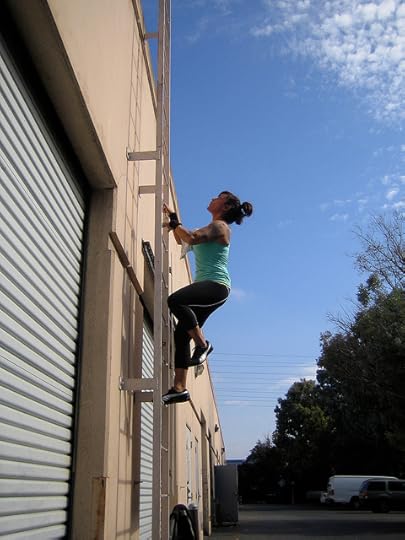

Her scene is on the roof of this huge industrial building. It was kind of sketchy; you're not supposed to be able to get up there. But we shimmied up the ladder with all of our gear and shot her at the top, just so we could have a nice view of the sky.

What about the running portion?
We were driving around with Brian MacKenzie, trying to find a good spot to shoot his stuff, and we ended up finding a cool place right off of the freeway in San Mateo. We pulled over and ended up shooting a lot of different angles, because I wasn't sure I was going to use them at cut. There's a ton of footage of him just running around and going through trees and trails, but we only ended up using a tiny portion of it.
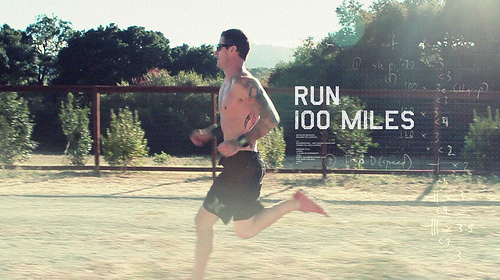
And the second to last shot: the Parkour jump over the wall?
We shot that with Brian Orosco at Ocean Beach in San Francisco, and he was just coming off of a sprained ankle, so he wasn't even up to par. It was a little scary because we weren't sure how many takes we would get. He was totally doing us a huge favor and after the first jump, we didn't expect to get another take. We figured he would hurt himself or something and we'd have to move on. But he was great. He did that jump four times, I think. And the one we ended up using in the trailer was what he called "The Lazy Boy," where he puts his hands behind his head and jumps off.

Brian on top of the world. Not a small wall.
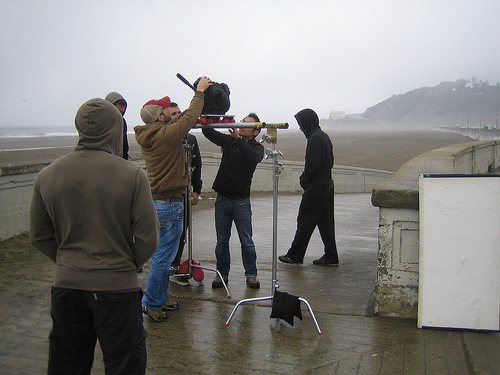
The set-up for one of four total camera angles.

We have to talk about the original ending. The first time Tim and I watched it, we busted out laughing. It just didn't work.
[Laughs] Yeah. When Tim first spoke to me about the trailer, he told me a theme of his book was "becoming superhuman." And one of the things that I put in my original treatment was that it would be cool at the end (after Brian jumps off the wall) if it were actually Tim who slams down in the final shot. So I wanted to do this totally epic comic book-style, like "Sin City" or something, where Tim would smash down on his knee and look up at the camera. That was the plan, at least.
[TIM: Here's what the rough cut looked like, using placeholder numbers for experiments, test subjects, etc. Try and keep a straight face at the end.]
Keep in mind that this shot would only look good after a lot of work in post-production. But it was basically Tim softly dropping down to the ground, which looked extremely silly while we were shooting it. I still think that if I'd had some time to fix the shot, it probably would have turned out cool. But in the first round of edits, it just looked like a joke.
Tim called me right after he saw it for the first time, and he couldn't stop laughing. He suggested we replace him with the book slamming down instead.

The book was just a high-res still of the cover, and I rebuilt it in 3D using After Effects. I took the different planes, rebuilt a book shape, and just slammed it down. I added dust particles and concrete cracking and all that stuff to make it seem more energetic than just a cut to the book's title.
What kind of gear did you and your crew use during this shoot?
My crew consisted of Phillip Briggs (cinematographer), Jeremy Wong (1st AC), Chris Galdes (gaffer), and Chris Bennett (grip). Below is the full list of video gear I had to use for this shoot (minus lighting equipment).
Cameras from the shoot:
- Canon 5D
- Canon 7D
- GoPro HD Camera (for the underwater shot)
Camera Lenses:
- Canon EF 100mm f/2.8L IS Macro
- Canon EF 14mm f/2.8 Mark II USM
- Canon EF 28-300mm f/3.5-5.6 IS USM
My workstation set up:
- 8 core Mac Pro (2 x 2.8GHz Quad-Core Intel Xeon) with 10GBs of RAM
- 2 x 24″ Apple Cinema Displays
- Medium Intuos 4 Wacom Tablet (I use this instead of a mouse)
Software/Plugins I used for trailer:
- Final Cut Pro
- After Effects
- Twixtor (for all slow motion shots)
- Magic Bullet Looks (for color correction)
Footnotes and Cautionary Notes from Tim
But what about the music? Ahhhhh…. music. You capricious little minx, you.
The entire trailer started as a fantasy while listening to Sevendust's "Splinter" track in an airport. I chartered Charlie with identifying the route to licensing and the costs involved.
At first glance, it appeared that, for online use only, we needed to pay approximately $320 to either ASCAP or BMI, two large clearing houses for licensing music.
In the beginning, it seemed so simple. That is, until is wasn't simple at all. Here's what we found in the rabbit hole, partially from ASCAP and partially from industry mentors:
There were six writers on the title "Splinter" performed by the band known as "Sevendust":
John M Connolly
Vincent E Hornsby
Edward Clint Lowery
Corey French Lowery
La Jon Witherspon
There were four related publishers, listed below, Chrysalis being the primary and the place the start:
Publishers/Administrators:
CHRYSALIS MUSIC
DARK NEW MUSIC
KAYLA 1 PUBLISHING
VEH PUBLISHING
Once determining the above, the standard next steps were then:
Issue a "quote request" to the publishers (starting with Chrysalis) indicating the various rights and terms we were looking to clear. The request could start with "initial rights", the most narrow we could manage, followed by "options" for broader rights. To begin the quote request, we'd need to define the scope of rights sought:
Initial Rights:
Media: Internet and TV (Need to specify if this is "all tv", free tv, cable, satellite, etc.)
Territory: For Internet, it's the world; for TV, is this for "Good Morning America" in the US only? North America?World?
Timing: What is the length of the use — how much of the track? Is it edited or interrupted?
Nature: Is it a background vocal? Background instrumental? Visual vocal? How is the song being used (i.e. In what context)?
Term: 6 months minimum with two options for 1 year, then 3 years? Additionally, there would be a master recording which needs separate clearance.
Sevendust's "Splinter" also came out through Asylum, who would be the label to clear the master, typically on an MFN basis (most-favored-nation) with the publisher's quote. While it might be helpful to have a relationship with the band (to approve the use and help expedite the process), ultimately we'd have to deal with the publisher and label at the end of the day.
Sound complicated? It should, and that was just the tip of the iceberg.
It was then time for disaster-recovery planning.
Since the trailer made no sense without accompanying music, and "Splinter" was up in the air, I began to look for sound engineers as a back-up insurance policy. For a 60-second original track, the cost could range from $500 to well over $10,000, all depending on the complexity of the score, their reputations, past clients, etc.
Based on Adam's original recommendations, I ended up working with two engineers/musicians: Steve Emerson and Dave Groseclose.
Re-editing the visuals before launch was impossible, so their tracks would need to match the cadence of our cuts. Both Steve and Dave were excellent to work with. Here are two of their samples:
Steve Emerson:
Dave Groseclose:
Incredibly, at the 11th hour — literally, late the night before the final video deadline — we received the official go-ahead to use Sevendust's track online, and I owe a huge debt of gratitude to Alvin Witherspoon, LJ's father; Tony Couch, Sevendust's manager; and Aaron Ray of The Collective for making it happen.
Last but certainly not least, thank you to Sevendust for creating such incredible music. If you haven't heard their stuff, you should absolutely grab either Cold Day Memory or their acoustic Southside Double-Wide.
In summary: If you're on deadline and need music, either hire a professional (such as a seasoned production company) to manage the complexity, or hire a sound engineer from the outset. Licensing tunes is not for the faint of heart.
The Morale (and Moral) of the Story
This trailer was incredible fun to create. It was also extremely stressful towards the end, with more than a few late-night sessions fueled by wine and caffeine.
The entire experience was infused with an anticipation wouldn't have existed without the ambitious "create the best X ever" goal. I also believe, as smooth as most things were, it could have gone horribly wrong without a few key ingredients:
- A well-defined vision for the end product
- In-depth review of Adam's prior reels, as well as in-person discussion, to ensure an aesthetic match.
- Two brainstorming sessions with Adam prior to making things official, to ensure a collaborative match. Creative headbutting, as opposed to give-and-take, creates delays. The request for treatment was also to observe his response time, which was outstanding. Remember: reliability and on-time delivery is more important than optimal skill set.
- Alignment of interest: Instead of focusing solely on price, Adam and I looked at how we could help each other. He was eager to show-off his killer directorial abilities in addition to his post-production skills, and the trailer provided an outlet.
As I've written before and still maintain:
It's lonely at the top. 99% of the world is convinced they are incapable of achieving great things, so they aim for the mediocre middle-ground. The level of competition is thus fiercest for "realistic" goals, paradoxically making them the most time- and energy-consuming. It is often easier to raise $10,000,000 than it is $1,000,000. It is easier to pick up the one perfect 10 in the bar than the five 8s.
If you are insecure, guess what? The rest of the world is too. Do not overestimate the competition and underestimate yourself. You are better than you think.
Unreasonable and unrealistic goals are easier to achieve for yet another reason.
Having an unusually large goal is an adrenaline infusion that provides the endurance to overcome the inevitable trials and tribulations that go along with any goal. Realistic goals, goals restricted to the average ambition level, are uninspiring and will only fuel you through the first or second problem, at which point you throw in the towel. If the potential payoff is mediocre or average, so is your effort. I'll run through walls to get a catamaran trip through the Greek islands, but I might not change my brand of cereal for a weekend trip through Columbus, Ohio. If I choose the latter because it is "realistic," I won't have the enthusiasm to jump even the smallest hurdle to accomplish it. With beautiful, crystal-clear Greek waters and delicious wine on the brain, I'm prepared to do battle for a dream that is worth dreaming. Even though their difficulty of achievement on a scale of 1-10 appears to be a 2 and a 10 respectively, Columbus is more likely to fall through.
The fishing is best where the fewest go. There is just less competition for bigger goals.
As the Romans (or at least Turnus) would say: "Fortes fortuna adiuvat!"
Fortune favors the bold. Have fun with it.







March 19, 2011
The Slow-Carb Diet™ Cookbooks — Available for 72 Hours
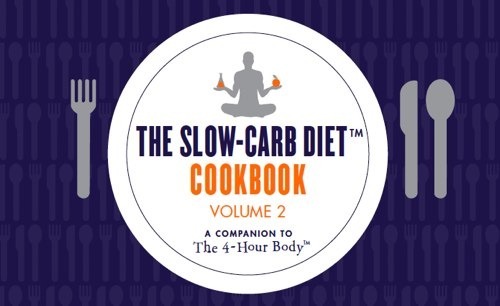
This will be my shortest post to date.
For fun (and karma), I've been quietly working to compile two cookbooks with simple and delicious recipes for The Slow-Carb Diet™.
Now, both volumes are done!
The Slow-Carb Diet™ Cookbook – Volume One
The Slow-Carb Diet™ Cookbook – Volume Two
Thanks to full-color printing through Blurb, the books are gorgeous. They're also not inexpensive, but 100% of my proceeds are being donated directly to QuestBridge, which helps put the smartest, low-income students in the US into the best colleges. I don't receive a single penny.
It's a highly leveraged program, and some of the brightest minds in Silicon Valley are advisors. $25,000 covers the cost of financial aid applications for 2,000 low-income high school students!
I hope you love the cookbooks. The goal is to make The Slow-Carb Diet™ more effective and fun for you, all while changing the lives of 1,000s of students. As a test, these books are available for the next 72 hours only, ending Tuesday, March 22, at 6pm PST.
Enormous thanks to all of the contributors, including chefs, foodies, successful readers, and friends like Mark Sisson, Darya Pino, and Jaden Hair.
Rock on.
(For those interested, I plan on posting further updates on the official blog of The Slow-Carb Diet)












